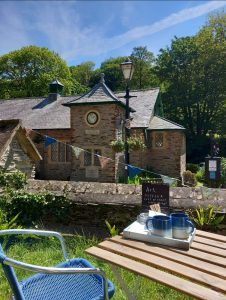
If you’re looking for the perfect combination of quaint village charm and stunning rugged scenery, you can’t do much better than Lee Bay. Located just a brisk walk from our doorstep down the beautiful Fuchsia Valley, it’s the perfect destination to enjoy a bit of quiet seaside scenery, watch the ebb and flow of the tides and perhaps retreat to the warmth of a local pub. But modern appearances can be deceptive, and many visitors are surprised to learn that once upon a time Lee Bay was notorious for something else entirely: smuggling!
From the rumours of wreckers, who lured ships onto the rocks in order to plunder their cargo, to notorious smugglers who managed to escape conviction, the history of smuggling in Lee Bay is a rich tapestry. Farms, cellars and outhouses in the area were frequently raided by the Revenue Men – agents of the crown sent to crack down on those avoiding import duties – who were frequently evaded. Some reports from the time suggest they were not always unsuccessful though, as in the case of John Beer in Lee, whose outhouse was found to have been stocked with contraband: “On the 23rd of June 1786; three hampers containing sixty six bottles of gin, about thirteen gallons red Portugal wine, about two hundred and fifty pounds white salt, and one box with seventy three packs playing cards without the ace of spades, seized in the outhouse of John Beer at Lee”. The playing cards are notable – no doubt the reader is aware of the reputation that the black spot has in pirate lore, but you may be surprised to learn that this is actually wholly unrelated. In 1765 the tax office introduced a standardised design for the card which could only be printed by those who had paid the correct duty. In essence it was proof that printers were operating legally, and decks which legally held them were “frizzled”.
 Another fearsome figure of the time is the famed smuggler Hannibal Richards, who moved to the area from Cornwall after spending time in the notorious Cruel Coppinger’s gang. Richards spent 60 years in the Lee Bay area plying his trade until his eventual death in 1849. He was never convicted of his crimes and is buried in Ilfracombe’s Holy Trinity Churchyard.
Another fearsome figure of the time is the famed smuggler Hannibal Richards, who moved to the area from Cornwall after spending time in the notorious Cruel Coppinger’s gang. Richards spent 60 years in the Lee Bay area plying his trade until his eventual death in 1849. He was never convicted of his crimes and is buried in Ilfracombe’s Holy Trinity Churchyard.
For a more gruesome tale why not visit the trail at Lee Bay known as Smuggler’s Leap? This is a steep rocky path leading to Sandy Cove – itself a hub of illicit activity and understood to be where much of the contraband in the area was brought ashore – which, as local legend dictates, is the spot where a smuggler on horseback fell to his death while being chased by one of the crowns Revenue Men, who followed him in his fate. Nowadays it’s a beautiful (if a little taxing) hike that makes up part of Lee Bays ‘Smuggler’s Path’, and is well worth the visit for those visitor’s seeking a mix of stunning scenery and living history.
Ultimately these days Lee Bay is a lot more tame than ever it used to be, but for fans of history that are keen to retrace the steps trod by pirates, bootleggers and smugglers there are few better places in the country.


